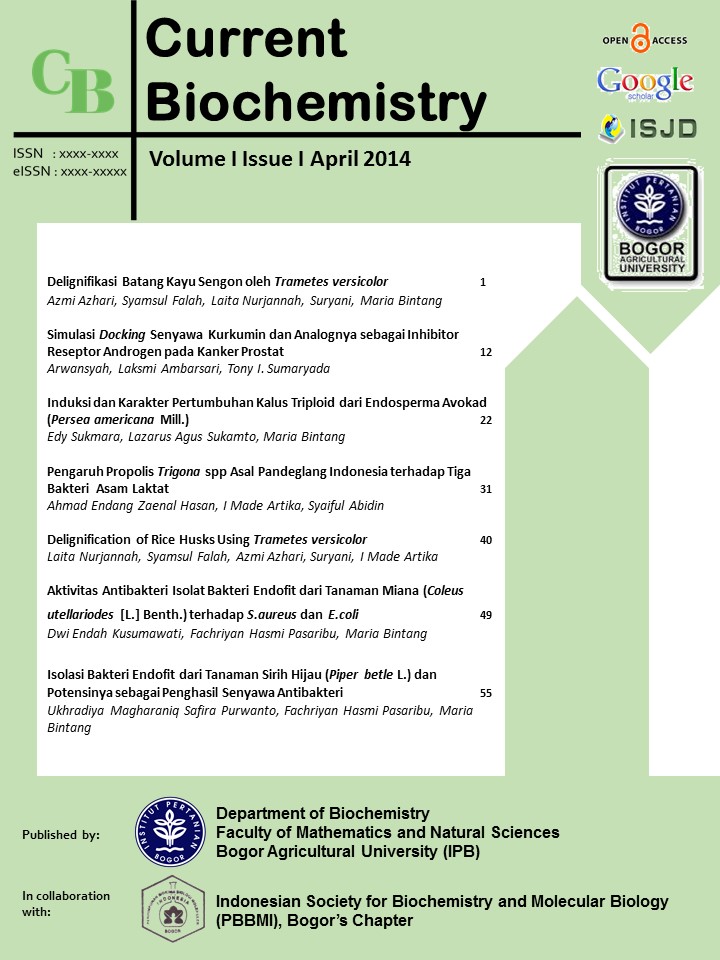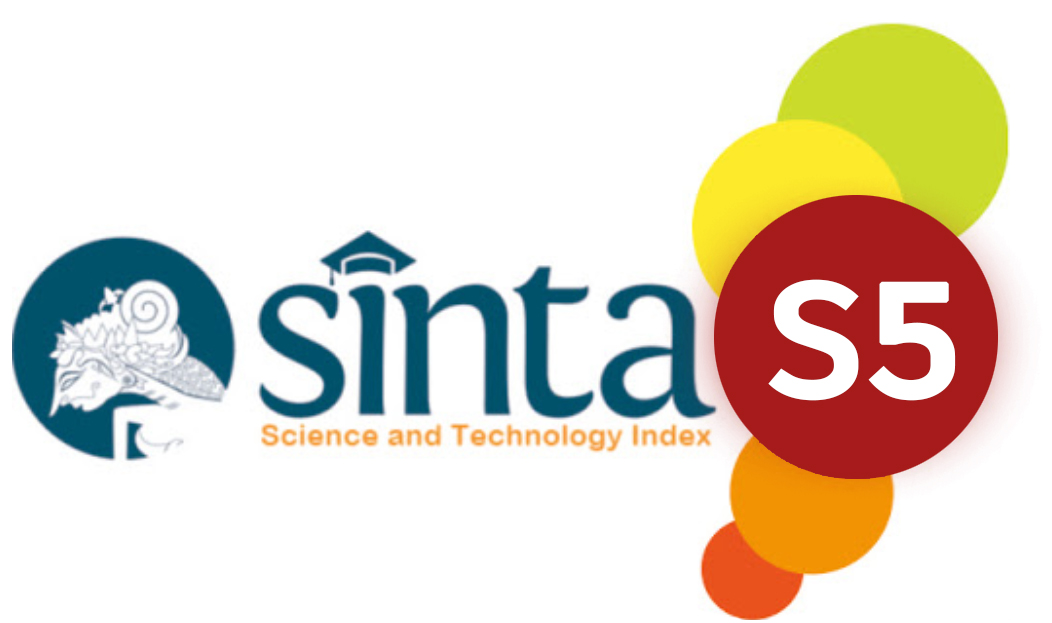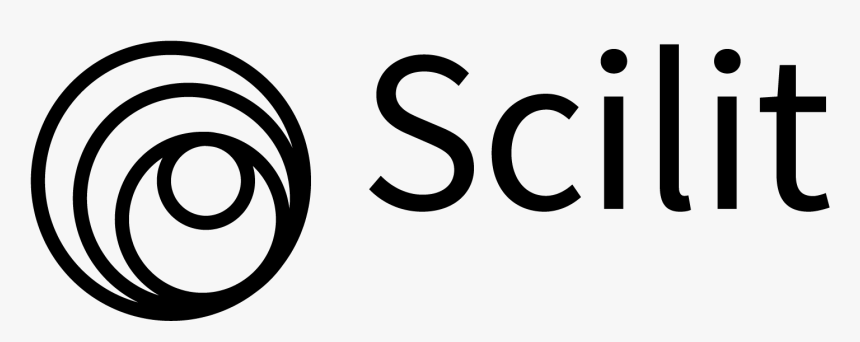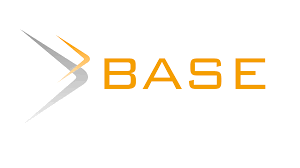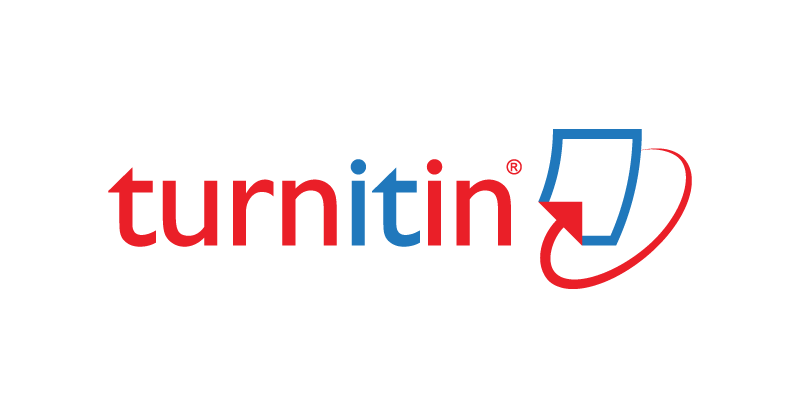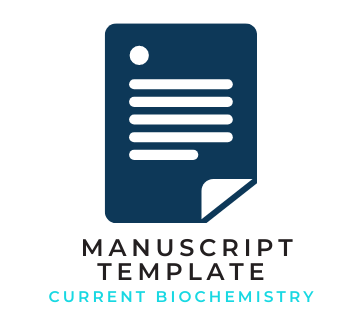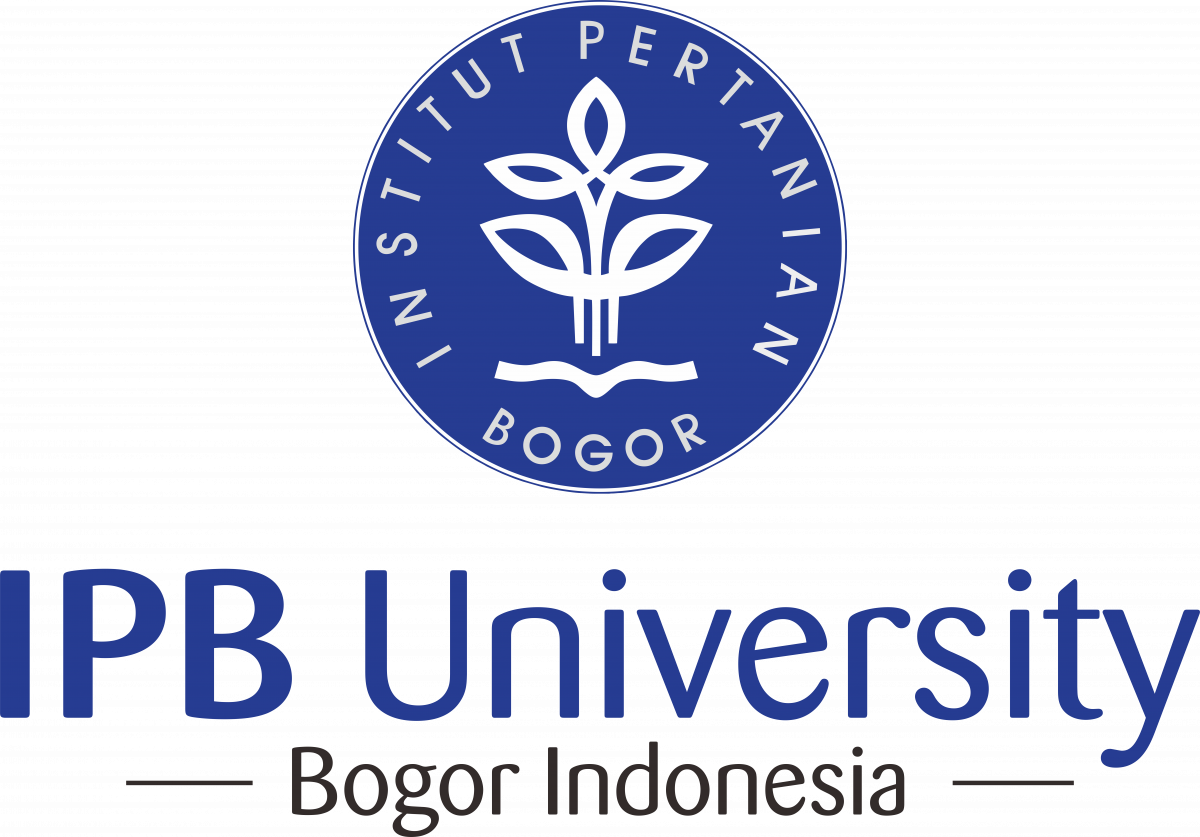Simulasi <i>Docking</i> Senyawa Kurkumin dan Analognya Sebagai Inhibitor Reseptor Androgen pada Kanker Prostat
Abstract
Curcumin, the major compound of Curcuma longa L, has been proven to have the toxicity effect on prostate cancer cell. This research was aimed to study the affinity and interaction of curcumin and its analogs as compettitive inhibitor to androgen hormon before working in vitro/in vivo research. Curcumin and its analogs were transformed into 3D structure, then docked to androgen receptor (3B67). The data of Gibbs energy (?G) value showed stability interaction between ligand and androgen receptor residues. The docking results showed that curcumin and its analogs have potential as inhibitor on androgen receptor. Based on results ?G score, analog 4 (1,7-bis-(3,4-dihydroxy-phenyl)-hepta-1,6-diene-3,5-dione) has highest potential as the inhibitor for androgen receptor.
References
Aggarwal BB. 2008. Prostate cancer and curcumin. Cancer Biology & Therapy. 7(9): 1436-1440.
Anand P, Thomas SG, Kunnumakkara AB, Sundaram C. 2008. Review bioavability of curcumin : problem and promises. Molecular pharmaceuticals, 4(6): 807-818.
Bohl CE, Wu Z, Dalton JT. 2008. Effect of B-ring substitution pattern on binding mode of propionamide selective androgen receptor modulators. Bioorg Med Chem Lett. 18: 55675570.
Bosshard HR, Marti DN, Jelesarov I. 2004. Protein stabilization by salt bridges: concepts, experimental approaches and clarification of some misunderstandings. J. Mol. Recogn. 17(1): 1-16.
Buckingham AD, Fowler PW, Hutson JM. 1988. Theoretical studies of van der Waals molecules and intermolecular forces. Chem. Rev. 88(6): 963–988.
Culig Z, Klocker H, Bartsch G, Hobisch A. 2002. Androgen receptors in prostate cancer. Endocrine-Related Cancer. 9: 155-170.
Deeb D, jiang H, Gao X, Hafner MS. 2004. Curcumin sensitizes prostate cancer cells to tumor necrosis factor-related apoptosis-inducing ligand/Apo2L by inhibiting nuclear factor-KB through suppression of IKBA phosphorylation. Mol Cancer Ther. 3(7): 803-812.
Donaldson MS. 2004. Nutrition and cancer: A review of the evidence for an anti-cancer diet. Nutrition Journal. 3:1-19.
Fitriasari A, Wijayanti NK, Ismiyati N, Dewi D, Kundarto W, Sudarmanto BA, Meiyanto E. 2008. Studi potensi kurkumin dan analognya sebagai Selective Estrogen Receptor Modulators (SERMs): Docking pada reseptor estrogen ß. Pharmacon. 9(1): 27-32.
Gan L, Chen S, Wang Y. 2009. Inhibition of the androgen receptor as a novel mechanism of taxol chemotherapy in prostate cancer. Cancer Res. 69: 8386-8394.
Gaurisankar S & Tanya D. 2008. Anti cancer effects of curcumin: cycle of life and death. Cell Division 2008. 3:1-14.
Girija CR, Karunakar P, Poojari CS, Begum NS, Syed AA. 2010. Molecular docking studies of curcumin derivative with multiple protein targets for procarcinogen activating enzyme inhibition. J Proteomics Bioinform. 3(6): 200203.
Glowacki ED, Vladu MI, Bauer S. 2013. Hydrogenbonds in molecular solids-from biological systems to organic electronics. J. Mater. Chem. B. 1: 3742-3753.
Grynkiewicz & Slifirski 2012. Curcumin and curcuminoids in quest for medicinal status. Acta Biochim. Pol. 59(2): 201-212.
Lavery DN & Bevan CL. 2010. Androgen receptor signalling in prostate cancer: the functional consequences of acetylation. Journal of Biomedicine and Biotechnology. 20(11):1-7.
Lins L & Brasseur R. 1995. The hydrophobic effect in protein folding. Faseb J. 9: 535-540.
Lipinski CA, Lombardo F, Segawa T, Ko D. 2001. Experimental and computational approaches to estimate solubility and permeability in drug discovey and development setting. Adv Drug Deliv Rev. 46: 3-26.
Liu Z, Chen K, Dai H. 2008. Treatment drug delivery with carbon nanotubes for in vivo cancer. Cancer Res. 68(16): 6652-6660.
Nakamura K, Yasunaga Y, Segawa T, Ko D. 2002. Curcumin down-regulates ar gene expression and activation in prostate cancer cell lines. Int. J. Oncol. 21: 825-830.
Ohtsu H, Xiao Z, Ishida J, Nagai M. 2002. Antitumor Agents 217. Curcumin analogues as novel androgen receptor antagonists with potential as anti-prostate cancer agents. J. Med. Chem. 45: 5037-5042.
Pchejetski D, Bohler T, Brizuela L. 2010. Fty720 (fingolimod) sensitizes prostate cancer cells to radiotherapy by inhibition of sphingosine kinase-1. Cancer Res. 70: 8651-8661.
Pebriana RB, Romadhan AF, Yunianto A, Rokhman MR. 2008. Docking kurkumin dan senyawa analognya pada reseptor progesteron: studi interaksinya sebagai selective progesterone receptor modulators (SPRMs) Pharmacon. 9(1): 14-20.
Perpina EE, Arnold AA, Baxter D, Webb P. 2007. A surface on the androgen receptor that allosterically regulates coactivator binding. Proc Natl Acad Sci U S A. 104: 16074-16079.
Ravindran J, Prasad S, Aggarwal BB. 2009. Curcumin and cancer cells: how many ways can curry kill tumor cells selectively. AAPS J. 11(3): 495-510.
Scher H, Liebertz C, Kelly WK, Mazumdar M. 1997. Bicalutamide for Advanced Prostate Cancer: The Natural Versus Treated History of Disease. Journal of Clinical Oncology. 15(8): 2928-2938.
Shahani K, Swaminathan SK, Freeman D. 2010. Injectable sustained release microparticles of curcumin: a new concept for cancer chemoprevention. Cancer res. 70: 4443-4452.
Sharp KA & Honig B. 1990. Electrostatic interactions in macromolecules: theory and applications. Annu Rev Biophys Biophys Chem. 19: 301322.
Singh R, Chaturvedi N, Singh VK. 2012. In silico study of herbal compounds as novel MAO inhibitors for parkinsons disease treatment. Life Science Phar Res. 2: 81-98.
Trott O & Olson A. 2010. AutoDock vina: improving the speed and accuracy of docking with a new scoring function, efficient optimization and multithreading. J. Comput. Chem. 31: 455-461.
Veber DF, Johnson SR, Cheng HY, Smith BR. 2002. Molecular properties that influence the oral bioavailability of drug Candidates. J. Med. Chem. 45: 2615-2623.
Wallace AC, Laskowski RA, Thornton JM. 1995. LIGPLOT: a program to generate schematic diagrams of protein-ligand interaction. Protein Eng. 8 (2): 127-34.

